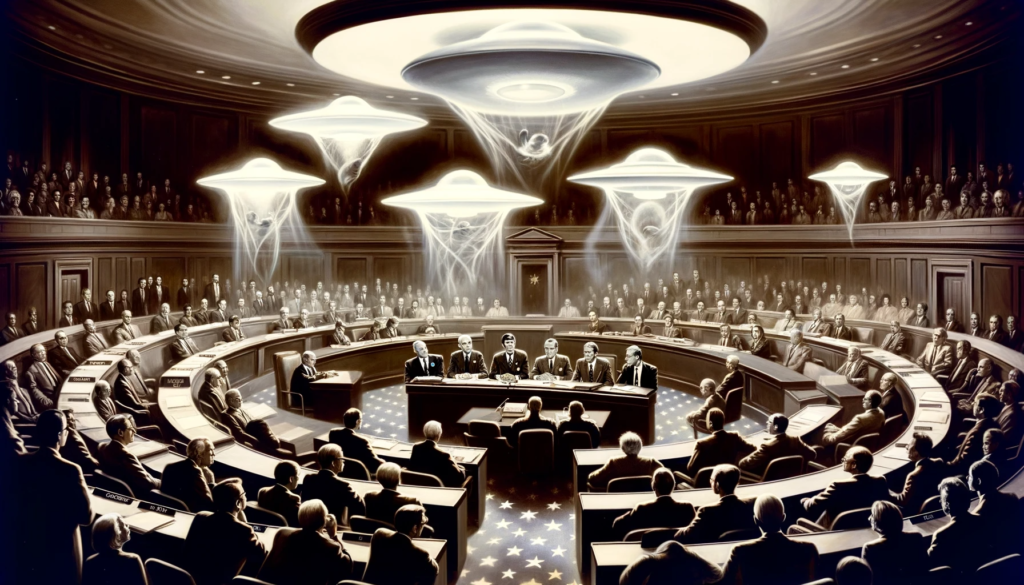Symposium on Unidentified Flying Objects

The “Symposium on Unidentified Flying Objects” held on July 29, 1968, was a landmark event in the annals of the study of UFOs. Organized by the U.S. House Committee on Science and Astronautics, it was one of the rare occasions where the phenomenon of UFOs was given a serious and thorough scientific inquiry on a public stage, that too within the august halls of the United States Congress. The session, chaired by Congressman J. Edward Roush, invited six scientists to present their research, views, and conclusions regarding UFO phenomena.
The symposium was unique due to its non-derogatory approach toward UFOs, eschewing the typical skepticism that was rampant during the time. Instead, it fostered an atmosphere of unbiased analysis and genuine curiosity. It sought to answer key questions that revolved around UFOs – their origins, the veracity of sightings, and their impact on public and national security. The scientists who testified presented differing viewpoints, with some attributing the sightings to natural phenomena and others advocating for the extraterrestrial hypothesis.
According to the proceedings of the symposium, Dr. James E. McDonald, Senior Physicist at the Institute of Atmospheric Physics and a professor in the Department of Meteorology at the University of Arizona, provided a detailed review of 41 unexplained UFO cases and stated his belief that UFOs were an extraterrestrial phenomenon. He stated, “My own study of the UFO problem has convinced me that we must rapidly escalate serious scientific attention to this extraordinarily intriguing puzzle.” (Source: Symposium on Unidentified Flying Objects – Hearings before the Committee on Science and Astronautics, U.S. House of Representatives, July 29, 1968)
Dr. Carl Sagan, an astrophysicist and a highly respected figure in the scientific community, was another key contributor. He presented an analysis advocating for the likelihood of life in the universe but argued for conventional explanations for most UFO sightings. However, he stressed the need for continued scientific study of the UFO phenomena, asserting that unusual phenomena should be examined with an open mind. (Source: Ibid.)
A significant outcome of the symposium was the ‘Condon Report’ commissioned by the Air Force and conducted by the University of Colorado. The report concluded that further study of UFOs was unlikely to be scientifically interesting, yet many argued the report’s conclusion was not representative of its content, which detailed numerous unexplained cases. (Source: The Scientific Study of Unidentified Flying Objects, Condon, E. U., & Gillmor, D. S., 1969)
Stanton T. Friedman, a nuclear physicist and prominent UFO researcher, argue that the symposium was an important step in legitimizing the study of UFOs.
Books like “UFOs: Generals, Pilots, and Government Officials Go on the Record” by Leslie Kean discuss the symposium as an instance where serious consideration was given to UFO phenomena at a governmental level. Kean’s work cites testimonies from the symposium as part of her argument for the need for a systematic, scientific investigation of UFOs.
The “Symposium on Unidentified Flying Objects” convened by the U.S. House Committee on Science and Astronautics on July 29, 1968, included six scientific experts who were invited to share their research, observations, and opinions on the UFO phenomenon. The speakers were:
- Dr. James E. McDonald: A senior physicist at the Institute of Atmospheric Physics and a professor in the Department of Meteorology at the University of Arizona. He presented an in-depth analysis of various unexplained UFO sightings and argued that UFOs could potentially represent an extraterrestrial phenomenon.
- Dr. J. Allen Hynek: An astronomer and professor at Northwestern University, he served as a scientific consultant for Project Blue Book, the United States Air Force’s official investigation into UFOs. His perspective was that of a former skeptic turned proponent for serious scientific study of UFOs.
- Dr. Carl Sagan: An astrophysicist and astronomer from Cornell University, Sagan was known for his research on the possibilities of extraterrestrial life. While he was open to the potential existence of extraterrestrial life, he believed that extraordinary claims required extraordinary evidence.
- Dr. Robert L. Hall: A social psychologist and professor at the University of Illinois at Chicago, he focused on the sociological aspects of UFO sightings.
- Dr. Donald H. Menzel: An astrophysicist and the Director of Harvard College Observatory, Menzel was a well-known skeptic of the extraterrestrial hypothesis.
- Dr. James A. Harder: A civil and hydraulic engineering professor at the University of California, Berkeley, he presented an analysis of physical evidence associated with UFO encounters.
The symposium was open to members of Congress, scientists, and the public. The attendees represented a wide range of interests and views on UFOs. Members of the U.S. House Committee on Science and Astronautics were present, led by Congressman J. Edward Roush, who chaired the symposium. The audience comprised fellow scientists, researchers, and individuals from the general public interested in the topic of UFOs. The media was also present, reporting on the proceedings of this significant event.
The Symposium on Unidentified Flying Objects was a significant attempt to bring scientific rigor and open-minded investigation into the contentious and often dismissed realm of UFOs. The diversity of opinions showcased at the event served to emphasize the complexity of the issue and the necessity for continued scientific investigation. But one thing is clear: the 1968 Symposium on Unidentified Flying Objects was an important milestone in our quest to understand these enigmatic occurrences.


